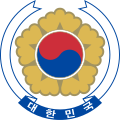Symbols
| Type | Symbol | Image | Notes |
|---|---|---|---|
| Flag | Flag of South Korea |  | The flag is known as the Taegeuki. It features a red and white taegeuk and four black trigrams. [1] |
| Emblem | Emblem of South Korea |  | The original version of the emblem was announced on 10 December 1963. [2] [3] [4] [5] The emblem is known as the Gukga Munjang or Gukjang, and features a taegeuk surrounded by mugunghwa petals. [6] |
| National anthem | Aegukga 애국가 |  | The term "aegukga" may generically refer to any patriotic song, but most often refers to the national anthem. The lyrics were written around 1907. The song was originally set to the tune of the Scottish folk song Auld Lang Syne, but new music was chosen in 1945. [7] |
| Folk song | Arirang 아리랑 | Arirang is a traditional Korean folk song that is included on the UNESCO list of Intangible Cultural Heritage as a symbol of both South Korea and North Korea. [8] [9] | |
| Seal | National seal Guksae |  | The Guksae is a square seal that is stamped on important documents and represents governmental authority. The current version of the seal has been in use since October 25, 2011. The handle of the seal features a pair of sculpted phoenixes. [10] |
| National motto | Hongik Ingan | Hongik Ingan (Korean : 홍익인간) is the official educational motto of South Korea. [11] The phrase can be translated to English as "To broadly benefit the human world". [12] | |
| National tree | Korean red pine (Pinus densiflora) |  | The Korean red pine is not an official symbol, but is often unofficially regarded as the national tree of South Korea. [13] |
| National flower | Mugunghwa |  | The Mugunghwa has been a symbol of Korea since ancient times. [14] |
| National bird | Korean magpie (Pica serica) |  | The magpie was chosen as the national bird of South Korea in 1964. [15] |
| National animal | Korean tiger ( Panthera tigris tigris ) |  | The Korean tiger is a historical and cultural symbol of the Korean peninsula and is important in traditional Korean culture. [16] |
| National currency | South Korean won | | The South Korean won was introduced in 1902. It was replaced by the hwan in 1952, but the won was reintroduced in 1962. [17] |
| Patron saint | Andrew Kim Taegon |  | Andrew Kim Taegon was Korea's first Catholic priest [18] and is the Catholic patron saint of Korea. [19] |
| National sport | Taekwondo |  | Taekwondo was officially designated as South Korea's national martial art in 2018. [20] |
| National dish | Kimchi |  | Kimchi has been a staple of Korean cuisine for centuries, and is regarded as the national dish of South Korea. [21] |
| National drink | Soju |  | The national drink of South Korea is soju, a grain-based spirit often served in shot glasses. [22] |